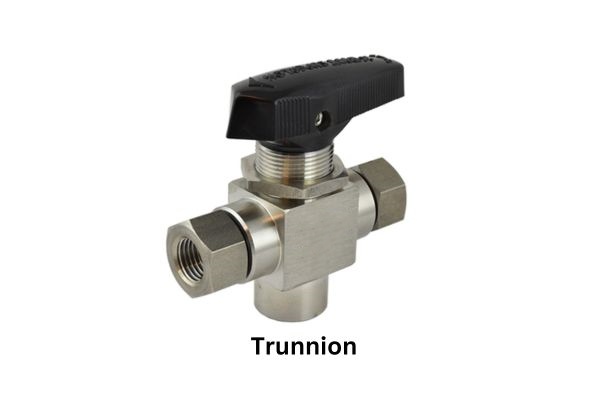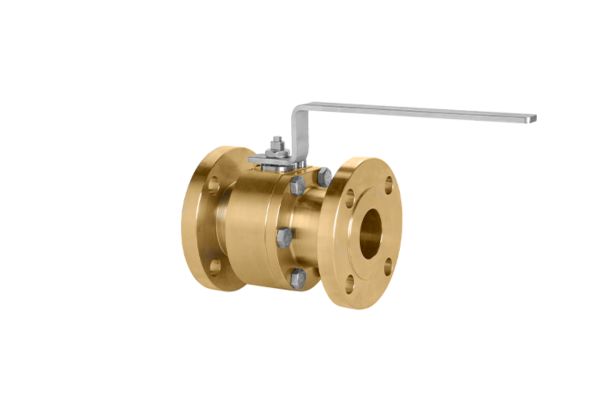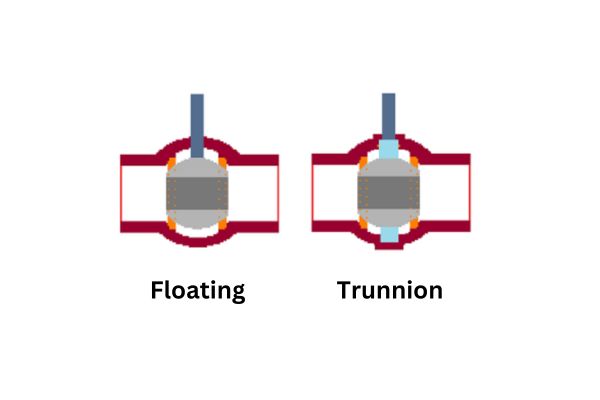Ball valves are essential components used to control the flow of fluids (liquids, gases, or slurries) in pipelines, offering quick, reliable operation with minimal flow resistance when open and a tight seal when closed. Widely used in industries like oil and gas, water treatment, and chemical processing, ball valves consist of a spherical ball with a port that rotates to either allow or block fluid flow, making them ideal for on/off control applications.
What is a Trunnion Ball Valve?
Definition and Function of Trunnion Ball Valves
A trunnion ball valve is a type of ball valve where the ball is fixed at two points, called trunnions, which are mounted on the top and bottom of the valve body. This design allows the ball to remain stationary while the valve is in operation. Trunnion ball valves are primarily used to control the flow of fluids in pipelines, offering a reliable means of managing high-pressure and high-flow systems. The main function of the trunnion ball valve is to start or stop the flow of fluids by rotating the ball inside the valve body, which either aligns or blocks the fluid path.

Key Features and Design of Trunnion Ball Valves
Fixed Ball Design: Unlike floating ball valves, the ball in a trunnion valve is fixed in place by the trunnions, which helps reduce stress on the valve seat and stem. This design is particularly suited for larger valves and higher-pressure applications.
Trunnion Mounting: The trunnion design provides additional support for the ball, preventing it from shifting under high-pressure conditions. This increases the valve’s stability and ensures a longer service life.
Reduced Torque: Since the ball is fixed, less torque is required to operate the valve compared to floating ball valves, making trunnion ball valves easier to handle in larger sizes.
Reliable Sealing: Trunnion ball valves provide excellent sealing performance, which is crucial for preventing leaks in high-pressure systems. Their robust sealing system ensures that the valve remains leak-proof even at high pressures.
How Trunnion Ball Valves Handle High Pressure and Large Flow Rates
Trunnion ball valves are specifically designed to perform well under high-pressure and high-flow conditions. The fixed ball design minimizes the stress on the valve seat and stem, reducing wear and tear and ensuring more reliable performance. This makes them suitable for use in large pipelines, such as those found in the oil and gas, chemical, and power industries, where both pressure and flow rate are substantial. The trunnion’s support also helps distribute the pressure evenly across the valve, reducing the risk of valve failure due to excessive force. With the ability to handle large flow rates and high pressure, trunnion ball valves are commonly used in critical systems where performance and reliability are paramount.
What is a Floating Ball Valve?
Overview of Floating Ball Valve Design and Mechanism
A floating ball valve is a type of ball valve where the ball is not fixed at any mounting points but instead “floats” freely within the valve body. The ball is held in place by the pressure of the fluid, which helps it align with the valve seat. When the valve is open, the port in the ball aligns with the pipeline, allowing the fluid to flow through. When closed, the ball rotates 90 degrees to block the flow, effectively sealing the valve. The floating ball mechanism allows for a quick, reliable on/off control, making these valves ideal for applications that require simple, straightforward fluid flow management.
The ball’s free-floating design ensures that it remains tightly pressed against the valve seat when closed, providing a secure seal and preventing leakage. The valve stem is connected to the ball, allowing for manual or automated operation to open or close the valve. Floating ball valves typically offer better flow control at lower pressures and are known for their compact design and ease of use.
How Floating Ball Valves Differ in Design from Trunnion Valves
Ball Support: Unlike trunnion ball valves, which have a fixed ball supported by trunnions at the top and bottom of the valve body, floating ball valves rely on the pressure of the fluid to keep the ball in place. This means that the ball is not mechanically anchored, allowing it to float freely and self-align with the seat.
Valve Operation: In trunnion ball valves, the ball is fixed, requiring less torque to operate and making them suitable for larger valves and high-pressure applications. In contrast, floating ball valves require the pressure of the fluid to press the ball against the seat to form a seal, making them more suitable for lower pressure and smaller systems.
Size and Pressure: Floating ball valves are generally used in smaller pipe sizes (up to 2-4 inches) and lower pressure systems, whereas trunnion ball valves excel in larger pipe sizes and higher pressure environments. The lack of trunnion support in floating ball valves makes them less suited for very large or high-pressure applications, as they can experience greater stress on the valve seat.

Best Applications for Floating Ball Valves
Low to Medium Pressure Systems: Floating ball valves are commonly used in applications where fluid pressure is moderate or low. They are ideal for smaller pipelines, including water, gas, and chemical distribution systems.
Residential and Commercial Plumbing: Due to their compact size and reliable sealing, floating ball valves are frequently used in residential plumbing systems for controlling water flow to fixtures, pumps, and other equipment.
Oil and Gas: Floating ball valves are used in oil and gas operations, particularly in pipelines that handle lower pressure or smaller volumes of fluid. Their reliable sealing and ease of operation make them a practical choice for these systems.
HVAC Systems: In heating, ventilation, and air conditioning (HVAC) systems, floating ball valves are often used to control the flow of refrigerants and other fluids, offering quick and efficient on/off control in moderate pressure environments.
Agricultural Applications: Floating ball valves are also used in agricultural irrigation systems, where they control the flow of water to crops, making them well-suited for systems that require durability and low to medium flow rates.
Trunnion vs Floating Ball Valve: Key Design Differences
Trunnion Ball Valve Design
Fixed Ball (Trunnion Ball Valve): In a trunnion ball valve, the ball is mounted securely at two points — the trunnions — which are fixed to the top and bottom of the valve body. This design ensures that the ball remains stationary during operation, regardless of the pressure inside the valve. The fixed ball setup is especially beneficial for larger valves and high-pressure systems, as it prevents the ball from shifting under fluid flow, reducing the risk of wear and ensuring a more stable sealing process.
Floating Ball (Floating Ball Valve): In a floating ball valve, the ball is not fixed, meaning it “floats” within the valve body. It is held in place by the pressure of the fluid, which forces the ball against the valve seat to create a seal. The free-floating ball design offers a more compact and simplified valve body, ideal for smaller, lower-pressure systems where high flow control is not required. This design allows the ball to align itself with the valve seat without the need for external support or trunnions.
Floating Ball Valve Design
Self-Aligning Ball Mechanism: The floating ball design relies on the pressure of the fluid to push the ball against the valve seat, creating a tight seal. The ball’s self-aligning nature allows it to automatically position itself against the seat when the valve is closed, ensuring minimal leakage. This self-adjustment is one of the key advantages of floating ball valves, as it reduces the complexity of the design while still providing reliable sealing under typical pressure conditions.
Sealing Mechanism: The floating ball’s self-aligning feature is critical in ensuring proper sealing. As fluid pressure increases, it forces the ball to move closer to the valve seat, effectively tightening the seal. This makes floating ball valves particularly effective in applications where precise on/off control is needed without complicated sealing systems. The design ensures a consistent seal but can be more prone to wear in high-pressure systems due to the stress on the valve seat.
How the Valve Stem Affects Performance in Both Designs
Trunnion Ball Valve Stem: In trunnion ball valves, the stem connects to the fixed ball, allowing for precise rotation and control. Since the ball is fixed, less torque is required to operate the valve, making the stem’s operation smoother, especially in larger, higher-pressure systems. The stem’s design in a trunnion ball valve ensures greater stability under heavy pressure, reducing the risk of stem wear and failure in high-stress environments.
Floating Ball Valve Stem: The stem in a floating ball valve is connected to the free-floating ball, allowing it to rotate and move the ball inside the valve. As the ball is not fixed, the torque required to rotate the valve is higher compared to trunnion ball valves. In floating ball valves, the stem’s operation is more influenced by the fluid pressure and flow, and higher torque might be required when the valve is larger or when operating under higher pressure. While it provides less ease of operation under extreme conditions, the floating ball stem design remains efficient for smaller-scale, lower-pressure applications.

Pressure Distribution and Stress Management in Each Valve Type
Trunnion Ball Valve: One of the main benefits of the trunnion design is its ability to distribute pressure evenly across the valve body. Since the ball is fixed in place, the pressure exerted on the ball is better managed by the trunnions, reducing the stress on the valve seat and stem. This makes trunnion ball valves ideal for high-pressure applications, as they maintain more stable sealing, minimize stress on the valve components, and extend the valve’s operational life under tough conditions. The fixed ball also minimizes the risk of ball deformation or wear from continuous fluid flow and pressure fluctuations.
Floating Ball Valve: In a floating ball valve, the pressure of the fluid forces the ball against the valve seat, which can lead to higher stress on the seat and stem. As the ball is not fixed, it can experience increased wear over time, especially in high-pressure systems. The pressure distribution is less controlled in floating ball valves, which is why they are better suited for low- to medium-pressure systems. The self-aligning ball compensates for some pressure fluctuations, but at the cost of increased stress on the sealing surfaces, especially if the valve is used in high-pressure or high-flow applications.
Valve Selection Guide: Choosing the Best Valve for Your System
Factors to Consider: Pressure, Flow Rate, and Fluid Type
Choosing the right valve for your system involves assessing several critical factors to ensure optimal performance, reliability, and longevity. Here are the most important considerations:
Pressure: Determine the maximum operating pressure your system will experience. Trunnion ball valves are well-suited for high-pressure applications due to their robust design and the ability to distribute pressure evenly. They handle extreme pressure conditions efficiently. On the other hand, floating ball valves are better for moderate to low-pressure applications. High pressures could lead to more wear on the self-aligning ball and seat, reducing the efficiency of floating ball valves over time.
Flow Rate: The required flow rate helps you decide the right size and type of valve. Trunnion ball valves are typically preferred for large pipelines with high flow rates due to their ability to handle large volumes of fluid without sacrificing control. Floating ball valves are more suited for systems with smaller flow rates or where quick on/off control is sufficient, as they perform best in applications where flow is moderate to low.
Fluid Type: The type of fluid in the system—whether it’s water, oil, gas, slurry, or chemicals—affects your valve selection. Floating ball valves are great for controlling clean liquids, gases, or slurries in low-pressure systems. In contrast, trunnion ball valves are more adaptable to various fluid types, including corrosive chemicals and slurries, as they offer better durability and sealing capabilities in harsh conditions.
Size, Material, and Specification Requirements
Valve Size: The size of the valve plays a crucial role in system performance. Trunnion ball valves are available in larger sizes, ranging from 4 inches to over 40 inches, and are ideal for heavy-duty applications. Floating ball valves, however, are typically found in smaller sizes (up to 2 to 6 inches), suited for residential, light industrial, and moderate-pressure systems.
Material: Valve material is directly related to fluid compatibility and environmental conditions. Common materials include:
Stainless Steel: For both trunnion and floating ball valves, stainless steel is a popular choice due to its resistance to corrosion and its ability to handle a wide range of fluids.
Carbon Steel: Used primarily for trunnion ball valves in larger, industrial systems, carbon steel is cost-effective and strong, but not as resistant to corrosion as stainless steel.
Brass: Often used in smaller floating ball valves, brass offers a balance of durability and cost-effectiveness for low-pressure applications.
Valve Specifications: Each valve type has specifications such as pressure ratings, flow characteristics, and temperature limits. Ensure the valve’s pressure rating matches your system’s maximum working pressure. Additionally, consider factors like end connections (flanged, threaded, or welded), operating torque, and seal material (e.g., PTFE, graphite) to ensure compatibility and optimal performance.
Trunnion vs Floating Ball Valve
Choosing between a trunnion ball valve and a floating ball valve largely depends on the operational requirements of your system. Here’s a quick guide to help you decide:
Choose a Trunnion Ball Valve if:
Your system involves high-pressure applications (above 150 psi or more).
You need large flow rates or are dealing with bigger pipeline sizes (typically 4 inches or larger).
The system handles harsh or abrasive fluids such as slurries, oils, or chemicals.
You need minimal maintenance and a valve that operates reliably under pressure for long periods.
Your system requires a more stable design to handle larger volumes and higher stresses.
Choose a Floating Ball Valve if:
Your system operates at lower pressure or moderate flow rates (generally under 150 psi).
You need a smaller valve size (usually under 6 inches).
Your application involves clean fluids like water, light oils, or gas.
You are looking for a cost-effective solution for standard on/off control.
Your application requires a compact valve design that is easy to install and maintain.
Conclusion
In summary, selecting the right valve is crucial for ensuring the efficiency, safety, and longevity of your fluid system. By understanding the key differences between trunnion and floating ball valves and evaluating your specific system needs, you can make a decision that balances performance, cost, and long-term reliability. Whether you prioritize high-pressure tolerance or cost efficiency, the right choice will enhance your system’s overall effectiveness and minimize the risk of failure.
FAQ
What is the main difference between a trunnion ball valve and a floating ball valve?
The main difference is that a trunnion ball valve has a fixed ball supported by trunnions, making it ideal for high-pressure and large-flow systems, while a floating ball valve has a free-floating ball, self-aligning with the seat, and is better for low- to medium-pressure systems.
Which valve is better for high-pressure applications, trunnion or floating?
Trunnion ball valves are better suited for high-pressure applications because their fixed ball design helps distribute pressure evenly and provides more stability in large systems.
Can floating ball valves handle large flow rates?
Floating ball valves are typically better suited for moderate flow rates. For very large flow rates, trunnion ball valves are a more appropriate choice due to their ability to handle higher pressures and larger volumes.
What types of fluids are best suited for floating ball valves?
Floating ball valves are ideal for handling clean liquids and gases at lower pressures. They are commonly used in water systems, HVAC applications, and light industrial processes.
Are trunnion ball valves more expensive than floating ball valves?
Yes, trunnion ball valves tend to be more expensive due to their more robust design, higher pressure tolerance, and suitability for larger systems. However, their durability and performance in high-pressure conditions often justify the cost.
How do I know if I need a trunnion or floating ball valve?
If your system operates under high pressure or requires large flow rates, a trunnion ball valve is the right choice. For smaller systems with moderate flow and lower pressure, a floating ball valve will be more cost-effective and efficient.







